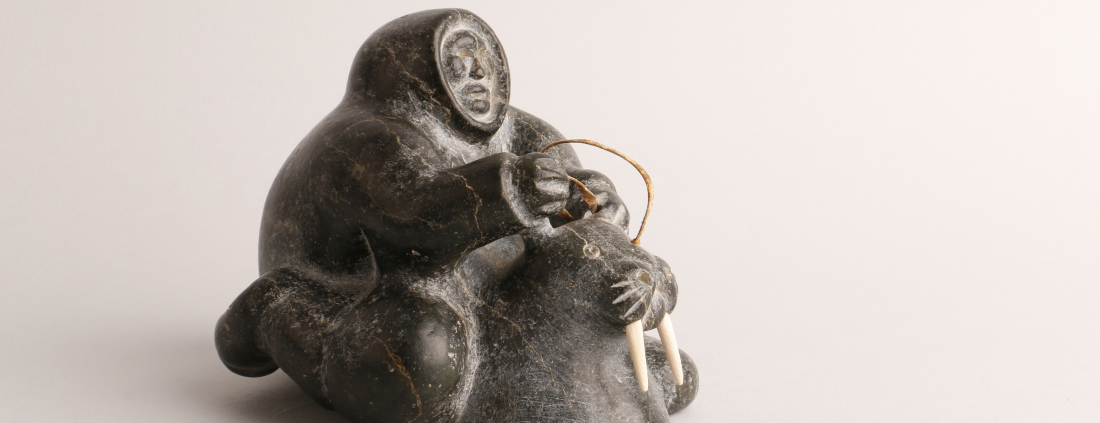Inukjuak – Cradle of Contemporary Canadian Inuit Art
Inukjuak is located on the northern bank of the Innuksuak River near Hopewell Sound on east Hudson Bay. The name of the settlement means “many people”. Ruins of stone houses from the pre-Dorset culture bear witness that this region has a long history of settlement. In the early days of the Colonization it was called “Port Harrison”.
Revillon Frères opened a trading post in Inukjuak in 1909. Revillon Frères was a French, globally active trading company for upmarket goods with fur products as its main item, which operated one of the first fur factories in Europe. In 1839, Victor Revillon acquired the Givelit company, which, at 116 years old, was now one of the oldest and most successful fur companies in Paris. The subsequent upswing of the company was based on two important business ideas. The first extremely successful idea of the Revillon couple was to make furs cheaper by also using fur types that had previously received less attention. The sons pursued a second business idea. Until then, the furs had only been processed into fur linings, trimmings and small fur items such as muffs, hats and scarves. Revillon began to process fur like fabric, first into jackets and then also into coats, always with the hair on the outside and according to the latest fashion. This expansion of the range revolutionized the entire furrier trade.
Fig. 1: Revillon Frères, purchase post (Credit: Wikipedia)
The company was so successful that it expanded to North America and procured the furs directly. In Canada, it thus competed with the powerful Hudson’s Bay Company, which maintained no fewer than 150 trading posts there. In 1920, the Hudson’s Bay Company also opened a trading post in Inukjuak. In 1926, the Hudson’s Bay Company acquired 54 percent of the company shares from Revillon Frères and in 1936 it was taken over completely by Hudson’s Bay.
Why such a long digression about the Revillon Frères company? Revillon had long had the idea of producing a film about the life of the Inuit, as the Inuit and First Nations were the main suppliers of skins. A film in Russia had not been made because of the February Revolution of 1917. In 1920, an expedition financed by Revillon began, planned for two years, to study and film the life of the Inuit. The film “Nanuk, the Eskimo” (original title: Nanook of the North; released in 1922) achieved worldwide fame and is one of the most important documentaries of the silent film era and one of the first feature-length films ever made. Director Robert J. Flaherty filmed the documentary about the everyday life of the Eskimo family of Nanuk and Nyla near the village of Inukjuaq.
Fig. 2: Original Movie Poster (Credit: Wikipedia)
But why is Inukjuak considered the cradle of contemporary Canadian Inuit art? James Houston discovered the craftsmanship of the Inuit here and convinced the Canadian Guild of Crafts in Montreal to show the artworks in sales exhibitions. In the years 1948-1950, he visited the camps that traded goods with the trading post in Inukjuak and showed the Inuit which objects (matchboxes, cigarette holders, ashtrays, …) could be created for the southern market using a booklet he had written and designed himself. Some of these old objects clearly show the influence of this brochure due to the decorations. Fortunately, these “souvenirs from the Arctic” did not catch on. The collector was much more interested in Arctic wildlife, the Inuit lifestyle and mythology.
The expressiveness of the small works of art did not go unnoticed by museum directors and, with the support of the Canadian government, the first Inuit art exhibition was shown in the Winnipeg Art Gallery as early as 1953.
After James Houston traveled to southern Baffin Island on behalf of the Canadian government in 1951 to explore the artistic abilities of the Inuit, Norman Ross, manager of the Hudson’s Bay trading post in Inukjuak, took care of the purchase and shipment of the artworks. In 1958, only 75 Inuit lived in the Inukjuak settlement. The remaining 263 lived in seven camps along the 160 km coastline and only visited the settlement for trading purposes. Each camp had its own camp leader, who was a respected figure and an exceptional hunter. The camp leaders quickly realized that the creation of small works of art was a more than welcome source of income after the collapse in the price of furs. They were among the first to sell works of art to James Housten. Among them were Akeeaktashuk (1898-1954, Camp Uugarsiuvik), Amidlak (1897-1961, Camp Quurnguq), Abraham Nastapoka (1900-1981, Camp Patirqtuuq) and Johnny Inukpuk (1911-2007, Camp Kuttaaq) all big names in today’s Inuit art world. Word of good things spreads quickly and so the camp leaders were soon followed by other members who also created great works of art, such as Abraham Talirunili P.O.V (1927-1994, Camp Kangirqsukallaq), Elijassiapik (1912-1972, Camp Kuttaaq) and Isa Smiler (1921-1986, Inukjuak).
Sources of information: “Wikipedia” and “Early Masters: Inuit Sculpture 1949-1955” (by Darlene CowardWight, The Winnipeg Art Gallery, 2006)




